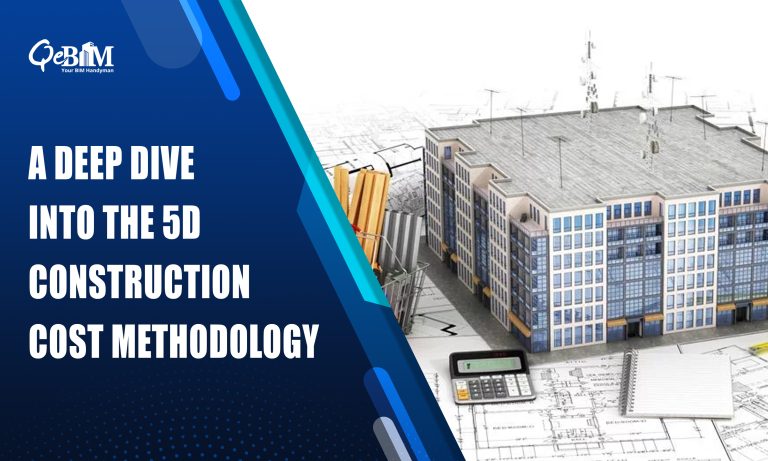A Deep Dive into the 5D Construction Cost Methodology

Introduction:
When considering construction and project management, staying in line with the given budget is a perpetual challenge. Traditional cost estimation techniques often fall short in providing a comprehensive understanding of project expenses, leading to unpredicted costs and delays. The 5D Cost Estimation Methodology has emerged as a revolutionary approach, offering a more clear and refined view on the project costs.
The below blog we will help you understand the intricacies of the 5D methodology, exploring its components and explaining how it contributes to efficient project management.
The Evolution of Cost Estimation:
The construction cost estimation has mostly been a 2D or 3D affair. It focuses majorly on the physical aspects of the project. However, these methods do lack the depth required for a thorough understanding and evaluation of costs. The 5D approach, on the other hand, covers/defines five dimensions, i.e., 3D geometry, time scheduling (4D), cost (5D), and an additional dimension for sustainability and facility management. This multidimensional view allows all the project managers to anticipate, analyze, and control the project costs more effectively.
1) 3D Geometry (The Foundation of 5D):
This dimension involves curating a detailed 3D model of the project. This is not just a blueprint, but a digital illustration that showcases every aspect of the building structure in the form of model. It also allows stakeholders and other members involved in the project to visualize its entirety, providing a strong foundation for subsequent cost estimation.
2) 4D Scheduling (Adding the Extra Element of Time):
Time is a critical factor when considering the construction projects, and the 4D component of the 5D methodology integrates scheduling into this equation. By linking the 3D model with a project schedule, stakeholders can visualize the construction process over time. This dynamic timeline allows for a more accurate prediction of when any specific resources will be needed and so on. It also aids in recognizing potential bottlenecks well ahead of time.
3) 5D Cost Estimation (Bringing Actual Numbers into the Picture):
The bottom of the 5D methodology lies in the integration of cost estimation into the digital model. Unlike traditional methods that estimate costs based on unit rates or historical data, 5D refers to the detailed 3D model as well as the project schedule to generate a more accurate and dynamic cost projections. This real-time cost visibility empowers project managers to make informed decisions and adjust plans as needed to stay within budget.
4) Additional Dimensions (Sustainability and Facility Management):
While the primary dimensions revolve around geometry, time, and cost, the 5D methodology can be extended to include other crucial aspects too. Factors such as sustainability and facility management can be considered to allow project managers to assess for the long-term environmental and economic impact of the construction choices. The additional dimension also helps optimize the ongoing operational costs, adding a layer of foresight beyond the construction phase.
Implementing the 5D Methodology:
1) Invest in BIM Technology:
The implementation of the 5D methodology begins with the adoption of BIM technology. BIM serves as the digital backbone, facilitating the creation of a detailed 3D model that summarizes the entire project.
2) Collaborative Planning and Input:
Engage all stakeholders, including architects, engineers, contractors, and clients, in collaborative planning sessions. Their input is valuable in assuring that the 3D model accurately reflects the project’s intricacies and goals.
3) Integration of Scheduling (4D) and Cost Estimation (5D):
Link the 3D model with project scheduling software to create a dynamic 4D model. Incorporate cost estimation parameters into the model, considering material costs, labour expenses, and other financial aspects.
5) Regular Updates and Adjustments:
The strength of the 5D methodology lies in its real-time capabilities. Regularly update the 4D model as the project progresses, adjusting cost estimations based on actual timelines, resource usage, and any unforeseen challenges.
6) Training and Familiarization:
Ensure that project teams are adequately trained in using the 5D methodology. Familiarity with BIM tools and understanding the interconnectedness of the dimensions is crucial for successful implementation.
7) Continuous Monitoring and Evaluation:
Implement a rigorous monitoring and assessment system to track the accuracy of cost estimations, identify areas of improvement, and make necessary adjustments throughout the project lifecycle.
Benefits of the 5D Methodology:
- Accuracy and Precision: The 5D methodology provides a more accurate and precise cost estimation by considering the multidimensional aspects of the project.
- Early Detection of Issues: The 4D schedule allows the project managers to identify potential issues and delays prior to implementation for proactive solutions.
- Enhanced Decision-Making: The Real-time visibility of costs and the comprehensive project insights empower stakeholders to make well-informed decisions at every stage of the project lifecycle.
- Improved Collaboration: The digital nature of the 5D model fosters better collaboration among project teams, architects, contractors, and clients, leading to a more cohesive and successful projects.
Conclusion:
As construction projects become increasingly complex and budgets becomes more stringent, the need for advanced cost estimation methodologies becomes essential. The 5D Cost Estimation Methodology stands as a top-notch notion of innovation, offering a comprehensive, multidimensional approach to project management. By integrating 3D modelling, scheduling, and cost estimation, BIM Service Providers can not only unlock the efficient project management but also ensures a more accurate and deep understanding of the financial aspects of the construction projects.
As the construction industry continues to evolve, embracing the cutting-edge methodologies like this as well as following a thorough implementation process, will be crucial for staying ahead of the competition and delivering successful and cost-effective projects.